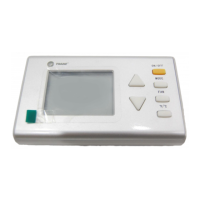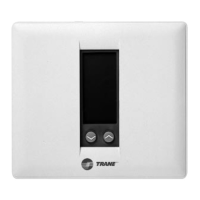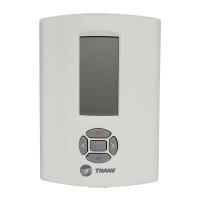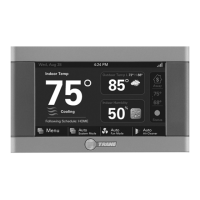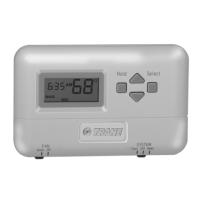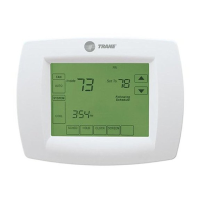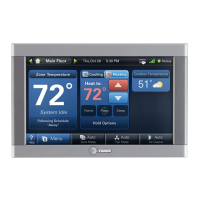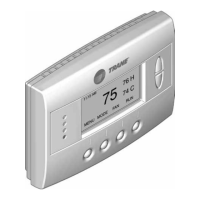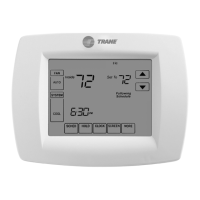BAS-SVX44A-EN 39
Other Thermostat Functions
Local/Remote/Outdoor Temperature Display and Control
The thermostat has the capability of displaying the local indoor temperature and/or the remote
indoor/outdoor temperatures, depending on the value setting for Configuration Option Number
0210. There are two terminals to connect the remote sensor, S1 and S2. The table that follows
provides information about displaying either local, remote, or outdoor temperatures and how
temperatures are controlled (refer to Configuration Option Number 0210 in Table 7, p. 24).
Option
Number 0210
Installer Parameter Number Value Description
0
Uses the internal/local sensor for Cool and Heat control. Displays only local indoor temperature.
1
Uses the internal/local sensor for Cool and Heat control. Displays both indoor local and remote
temperatures. Remote sensor typically placed outdoors.
(a)
(a) Remote sensor can be placed indoor or outdoor depending on the application.
2
Uses internal/local sensor for Cool and Heat control. Uses remote S1/S2 thermistor for compressor/
auxiliary heat lockout feature. Displays both indoor and outdoor temperatures. Remote sensor is typically
placed outdoors near compressor equipment.
(a)
(See Option numbers 0220/0221 and the section,
“Compressor and Auxiliary Heat Lockout,” p. 47, for more details.)
3
Uses S1/S2 thermistor for Cool and Heat control. The internal thermistor is disabled. Displays only the
remote indoor temperature and is displayed in the location normally reserved for the local thermistor.
Remote sensor is typically placed indoors where H/C control is desired.
(a)
4
Uses the average temperature of the local sensor and the remote S1/S2 sensor for Cool and Heat control.
No secondary temperature displayed. If either temperature is outside the measuring range, an error code
will display.
(b)
The average temperature is displayed in the location normally reserved for the local
thermistor. Remote sensor is typically placed indoors away from the thermostat to allow temperature
averaging from one side of a room to the other.
(a)
(b) If an out-of-range error occurs on either the local or remote thermistor (but not both), then the firmware will use the
good thermistor reading without averaging to control Cool or Heat cycles. If or when the bad thermistor returns to a good
state, then the firmware will return to using both thermistors and average the two values.
Indoor Temperature
Outdoor/Remote
Temperature

